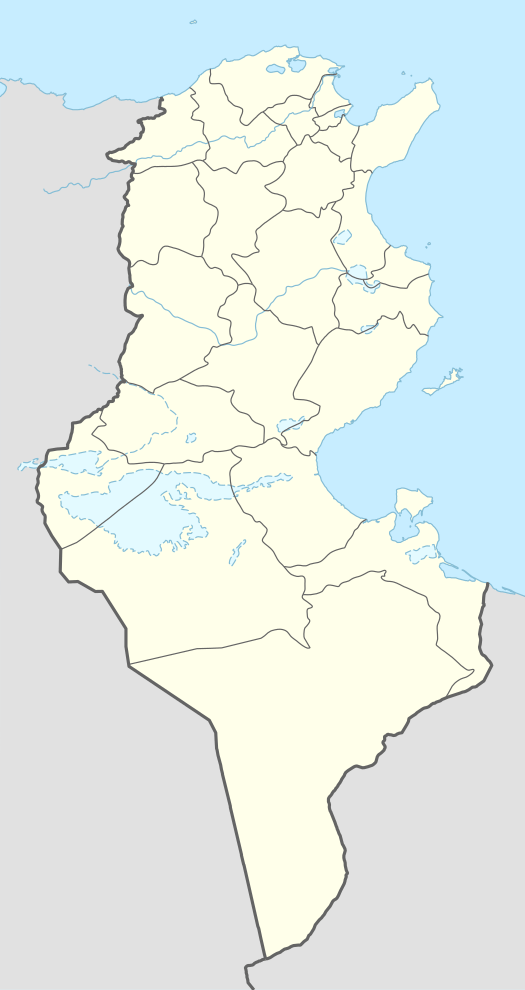Raqqada
Raqqāda (Arabic: رقّادة) is the site of the second capital, in Tunisia of the 9th-century dynasty of Aghlabids, located about ten kilometers southwest of Kairouan, Tunisia. The site now houses the National Museum of Islamic Art.
رقادة | |
 Raqqada's palace. | |
 Shown within Tunisia | |
| Location | Tunisia |
|---|---|
| Region | Kairouan Governorate |
| Coordinates | 35°35′46″N 10°03′25″E |
History
In 876, the ninth Aghlabid emir Ibrahim II ibn Ahmad (875-902) felt the need to change residence to find a quiet place away from city noise. The new city is provided with several palaces and a mosque. The Aghlabids founded a factory of textile and paper to supply the House of Wisdom and Science (Bayt al-Hikma). At a time, Raqqada became even larger than Kairouan.[1]
In 909, Abdullah al-Mahdi Billah, founder of the dynasty of the Fatimids, who had moved to Kairouan, finally settled in Raqqada. He chose another capital and founded the town of Mahdia. He proclaimed himself as the Imam in 909.[2]
The 7 July 969, the troops of the fourth Fatimid Caliph Al-Muizz Lideenillah entered Fustat in Egypt. The caliph founded a new city Cairo, which was now to be the capital. Raqqada was demolished after the construction of Cairo.[3]
After 1960, a presidential palace was built on a site of twenty acres, some remains of which are still visible, it houses since 1986 the National Museum of Islamic Art Raqqada.[4]
Excavation campaigns initiated in the early 1960s on the site of ancient palaces have yielded abundant fragments of pottery to glaze, including shards and tiles with a metallic sheen with floral and plant ( vine leaf stylized) and carefully decorated cuts (cutting the bird dating from the second half of the 9th century).[5]
National Museum of Islamic Art
.jpg)
The museum specializes in medieval Islamic art and includes works from Kairouan and Raqqada sites and Al-Mansuriya, a former princely city built in the Fatimid period.[4] Admission is vested in the Great Mosque of Kairouan and presents a reproduction of its mihrab and a model of the monument.[6] The next room contains collections of ceramics dating from the times when Raqqada was occupied (9th and 10th centuries). Another room contains collections of numismatic coins from different eras that illustrate the economic history of the Ifriqiya for more than six centuries.[7] The largest collection is that of Korans of exceptional calligraphy and a collection of manuscripts and pages belonging originally to the library of the Great Mosque of Kairouan. Among the gems of this collection, are the leaves of the Blue Koran dating from the 10th century.
References
- (in French) Musée national d'art islamique de Raqqâda par Mohamed Rebai
- Charles Saint-Prot, Islam, l'avenir de la tradition : entre révolution et occidentalisation. Essai, éd. Le Rocher, Paris, 2008, p. 195
- Janine et Dominique Sourdel (1 Jan 2004). Dictionnaire historique de l'islam. Paris: French & European Pubns. p. 702. ISBN 978-0686564461.
- (in French) Caroline Gaultier-Kurhan, Le patrimoine culturel africain, éd. Maisonneuve et Larose, Paris, 2001, p. 151
- Éric Delpont, Les Andalousies de Damas à Cordoue : exposition présentée à l'Institut du monde arabe du 28 novembre 2000 au 15 avril 2001, éd. Hazan, Paris, 2000, p. 194
- (in French) Musée des arts islamiques de Kairouan (Musée sans frontières)
- (in French) Musée national d’art islamique de Raqqâda (Patrimoine de Tunisie)